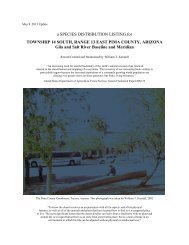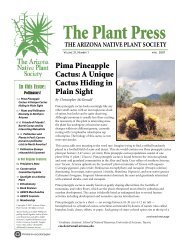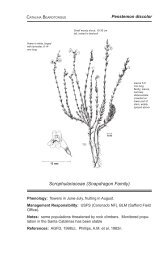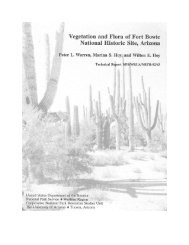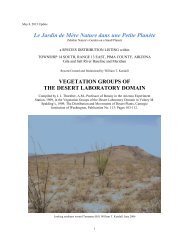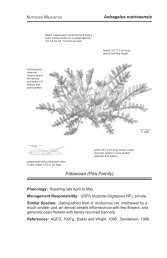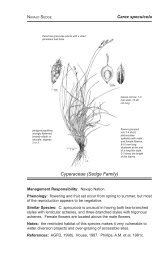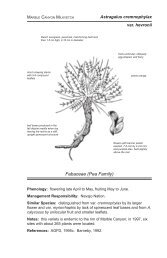Asplenium dalhousiae
Asplenium dalhousiae
Asplenium dalhousiae
Create successful ePaper yourself
Turn your PDF publications into a flip-book with our unique Google optimized e-Paper software.
DALHOUSE SPLEENWORT<br />
<strong>Asplenium</strong> <strong>dalhousiae</strong><br />
Fern with a rosette of<br />
fronds from a rhizome<br />
rachis green,<br />
scaly beneath<br />
blade pinnatifid,<br />
5-15 cm long;<br />
with six to thirteen<br />
pairs of lobes, the<br />
lobes 5-12 mm<br />
wide<br />
stipes shorter than<br />
the blade, blade<br />
narrowed toward<br />
the base<br />
Aspleniaceae (Spleenwort Family)<br />
Management Responsibility: BLM (Tucson Field Office).<br />
Synonyms: Ceterach <strong>dalhousiae</strong> (Hook.) in Mickel (1979).<br />
Similar Species: <strong>Asplenium</strong> <strong>dalhousiae</strong> is distinguished by its once<br />
pinnatifid leaves from <strong>Asplenium</strong> exiguum which has bipinnatifid leaves.<br />
Notes: also occurs in northern Mexico in the New World and is disjunct to<br />
the Himalaya Mountains in Asia.<br />
References: Mickel, 1979. Wagner, 1993.
<strong>Asplenium</strong><br />
<strong>dalhousiae</strong><br />
G. Yatskievych/AGFD<br />
Habitat: sky island species<br />
growing in shady, rocky<br />
ravines in moist soil with<br />
Madrean oak woodland at<br />
4,000-6,000 ft (1220-1830<br />
m) elevation.<br />
Mima Falk<br />
Range: scattered localities in the Mule<br />
Mountains, Sandy Bob and Box Canyons<br />
and the Baboquivari Mountains.



